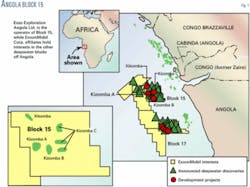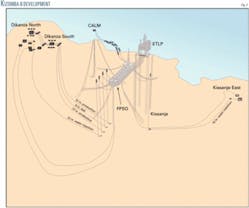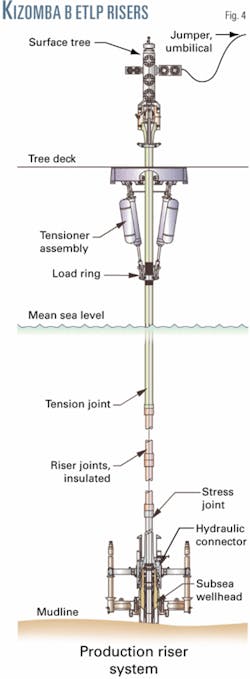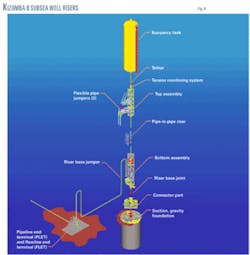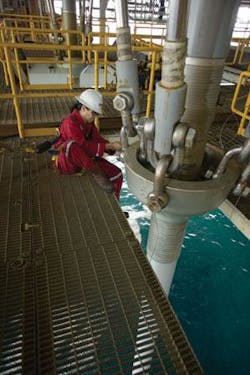The deepwater Kizomba B project, in Angola Block 15, completed the “design one, build multiple” strategy that Esso Exploration Angola (Block 15) Ltd., an affiliate of Exxon Mobil Corp., used for reducing the time and costs needed to fabricate and install large-scale facilities for producing deepwater oil fields.
The fields developed by Kizomba B are in 1,015 m of water. Facilities for the project were built and installed, in only 31 months and ramped up to their 250,000 bo/d designed peak capacity in a little more than 2 months after production started, according to Michael E. Flynn, deepwater vice-president of ExxonMobil Development Co.
Flynn attributed this success to ExxonMobil’s disciplined, standardized approach that took advantage of building two nearly identical facilities. Kizomba A, in 1,180 m of water, was completed first, with fabrication and installation requiring 36 months.
Both Kizomba A and B include the largest floating, production, storage, and offloading (FPSO) vessels built to date, as well as dry-tree completions on nearby extended tension leg platforms (ETLPs).
Kizomba B is the third facility to be installed by Esso in Block 15. Xikomba started production in November 2003 and Kizomba A commenced production in August 2004. Just 11 months later, oil started flowing through Kizomba B.
The three projects currently produce 550,000 bo/d, a rate previously not expected until first-quarter 2006, Flynn said.
Partners in Block 15 are Esso, 40%; BP Exploration (Angola) Ltd., 26.67%; Agip Angola Exploration BV, 20%; and Statoil Angola, 13.33%.
Esso operates the block under a concession agreement with Sonangol, Angola’s state oil company.
Block 15 development
Esso acquired its Block 15 interests in 1994 and drilling began in September 1997 with the first discovery in 1998. To date, Esso has announced 17 oil discoveries in the block (Fig. 1) and estimates the discoveries contain 4.5 billion boe of recoverable reserves.
Xikomba, Kizomba A, and Kizomba B developed five discoveries, while the planned Kizomba C project, now in the development planning stage, is expected to develop an additional three: Mondo, Saxi, and Batuque, with combined resources of about 650 million bbl of oil.
Kizomba A and B should each produce 1 billion bbl of oil.
The Kizomba C development will include only subsea wells tied-back to two FPSOs. Flynn does not expect any of the envisioned future developments in Block 15 to utilize additional dry-tree platforms due to different reservoir conditions.
Flynn also noted that a part of future operations in the block will likely involve the technology that ExxonMobil designed and licensed to a joint venture of BJ Services Co. and Otto Candies LLC. The technology consists of an intervention vessel for deploying a coiled-tubing subsea intervention module (SIM) for working over and recompleting subsea wells (OGJ, May 9, 2005, p. 20).
After the completion of Kizomba C, Esso estimates that the four projects will have developed about 3 billion bbl of recoverable reserves. To date Esso and its co-venturers have invested about $10 billion in the block, including the $3.6 billion for Kizomba A and the $3.4 billion for Kizomba B.
It developed the Xikomba field with an early production system because of the limited oil reserves in the field and to benefit from early revenue on the block. The field includes eight subsea wells (four producers, one gas injector, and three water injectors) tied back to a leased FPSO vessel. Water depths range from 1,305 to 1,366 m.
Esso estimates that Xikomba will recover about 104 million bbl of oil. The field started producing in November 2003 and had a peak production of about 80,000 bo/d.
As noted previously, the Kizomba B development scheme is nearly identical to the Kizomba A, except for the subsea architecture, which is unique in each project to optimize oil recovery.
ExxonMobil first implemented the “design one, build multiple” strategy by constructing three generic FPSOs for early production systems in fields that it operates. These were the Xikomba FPSO, the Falcon FPSO in the Yoho field off Nigeria, and the Serpentina FPSO in the Zafiro field off Equatorial Guinea. ExxonMobil leases these FPSOs from Single Buoy Mooring Inc. (SBM), which built the vessels.
Building multiples is central to ExxonMobil Development Co.’s strategy, Flynn said. He recounted that the company was formed with a unique global functional organization structure within ExxonMobil Corp. It was one of the five upstream functional companies formed and was designed to execute capital projects on a global basis, and its inventory of projects has tripled since then, Flynn added.
He explained that “our structure and global perspective, and ExxonMobil’s scale has given us the ability to identify standardization opportunities previously unrecognized and hence led to the concept of design one and build multiples.” He further added, “You have to resist the temptation to tinker, which at the time seems like optimization but looking back over the past couple of decades it’s not. People have tweaked a whole lot of things but many projects have gotten into trouble through unstructured change. Something that they thought was a small positive impact grew to be a big negative impact. We learned that lesson and we are very disciplined about managing change effectively.”
According to Esso the Kizomba B “design one, build multiple” development approach:
• Shortened cycle times to a record-setting 31 months from contract award to production.
• Shortened transition time from design to construction.
• Accelerated procurement activities, with 260 of the 273 ETLP and FPSO vendors being the same on Kizomba A and B.
• Improved execution by reusing many of the same suppliers and by sharing Kizomba A and B staff positions.
Flynn said Kizomba B includes about $500 million spent on Angolan goods and services, similar to Kizomba A expenditures.
About 400 Esso personnel work in Angola to operate and support the Block 15 developments with additional support from thousands of contractor personnel. Most of the Esso personnel on the projects are Angolan nationals.
Block 15 crude
The crudes produced by the three projects have some differences.
The Xikomba crude is a light, low sulfur crude with a 34.7° API gravity, 0.39-mass % sulfur, 3° C. pour point, 0.16-mg KOH/g total acid number (TAN), 12.0-ppmw nickel, 5.0-ppmw vanadium, 4.71-cst viscosity at 50° C., and 2.9 1b of salt/1,000 bbl.
Kizomba A produces crude from the Hungo and Chocalho field. This Hungo blend is a medium density, medium sulfur, and medium TAN crude. The blend has a 28.5° API gravity, 0.71-mass% sulfur, 36° C. pour point, 0.43-mg KOH/g TAN, 19.0-ppmw nickel, 17.0-ppmw vanadium, 12.9-cst viscosity at 40° C.
Kizomba B produces crude from the Kissanje and Dikanza fields. This Kissanje blend is a medium density, medium sulfur, medium TAN crude. The blend has a 28.2° API gravity, 0.44-mass% sulfur, 21° C. pour point, 0.64-mg KOH/g TAN, 16.1-ppmw nickel, 5.7-ppmw vanadium, 15.62-cst viscosity at 40° C.
Both Kizomba A and B facilities are designed to process the respective crude streams to a salt-content specification of less than 35 lb/1,000 bbl.
Kizomba B ETLP
The Kizomba B ETLP facilities handle production from the Kissanja field while the FPSO is directly tied into subsea wells in the Dikanza North and South fields, and the Kiissanje East area (Fig. 2). The dry-tree ETLP is in 1,000 m of water while the Dikanza North subsea wells are in 1,150 m of water.
The ETLP does not have any processing equipment for the produced fluid. All processing equipment is on the FPSO. The Kizomba B ETLP was the second dry-tree floater installed off West Africa. The Kizomba A ETLP was the first.
Esso’s list of ETLP features include:
• Extended porches allow a more efficient, lighter weight, lower cost hull to support a drilling rig and associated topsides facilities. The extended porch on the ETLP makes it competitive with other deepwater development concepts. The extensions on each leg provide a wider base to attach to the tendons, resulting in greater stability without the need for a heavier hull or topsides. Kizomba A was Exxon Mobil’s first use of the ETLP concept.
• Highly automated, state-of-the-art facility designed to maximize personnel safety and drill long-reach wells efficiently. The dry-tree completions minimize long-term costs for servicing wells. The ETLP accommodates a self-contained platform drilling rig with full-wellstream manifolds. The rig is owned by Esso and operated and maintained by Sonamer Management Co., a joint venture between Sonangol and Pride International Inc.
• Uses insulated top-tensioned production risers and drill riser.
• Can drill multiple wells without retrieving the drilling riser after each well.
The 30,000-tonne ETLP has a 133-m height, 75-m length, and 32-m width.
Eight 32-in. diameter tendons connect the ETLP to the seafloor. Esso installed the piles for the tendons during early 2005. The piles are each 84-in. diameter and weigh 298 tonnes each. Sonamet’s facility in Lobito, Angola, fabricated the piles.
The fully integrated ETLP reached the Kizomba B site in March 2005 aboard the Heerema Dockside Mighty Servant. Kizomba A was the first TLP transported in this fully complete manner.
One difference between the projects was that ABB Lummus Global designed the Kizomba A ETLP, which was integrated in Holland, with two topsides modules built by Heerema in Holland and the hull built by Daewoo Shipyard and Marine Engineering in Okpo, South Korea. The Kizomba B ETLP, on the other hand, was assembled and built almost entirely at the Daewoo Shipyard.
Another difference was that the Kizomba B ETLP deck has six smaller modules instead of the two on Kizomba A. But when assembled, the topsides look the same, according to Flynn.
The Kizomba B ETLP has slots for up to 36 dry-tree wells and a drilling unit that provides drilling, well maintenance, and intervention capabilities. Esso plans to drill 17 production wells and 12 injection wells from the ETLP. An additional 8 subsea production wells and 9 subsea water injection wells will be tied into the FPSO.
In comparison, the Kizomba A ETLP has 33 wells planned and an additional 21 subsea injection wells.
The subsea wells, except for the Kizomba B producers, will inject both gas and water for pressure maintenance. Esso also indicates that it has designed some subsea injectors to accommodate either gas or water injection for a water alternating gas (WAG) scheme.
Each ETLP dry-tree well (Fig. 3) connects to a seabed wellhead with a 103⁄4-in. by 0.450-in production riser that has Vetco-Gray Rl-PC riser connectors and direct-acting tensioners on the ETLP (Figs. 3 and 4). For flow assurance, the production risers are insulated.
Kizomba B FPSO
Esso awarded the Kizomba B FPSO contract during December 2002 and started building the FPSO hull while completing the Kizomba A FPSO. The Kizomba B FPSO was about 75% complete when the Kizomba A FPSO arrived in Angola, according to Flynn.
Hyundai Heavy Industries built the FPSO that is the largest yet constructed in terms of the 250,000-b/d production and 2.2-million-bbl storage capacity.
Thirteen mooring lines spread moor the vessel. Risers attached to buoyancy modules connect the subsea injection wells to the FPSO (Fig. 6).
The hull is 285 m long and 64 m wide, about the size of a modern double-hull supertanker. Unlike the Kizomba A FPSO that had some commissioning work during its 3-month voyage to Angola, Flynn said the Kizomba B FPSO was basically complete when it sailed from Korea in February 2005.
Flynn said that as a result of synergies generated by aggressively capturing “lessons learned” on Kizomba A and applying them in real time on Kizomba B, the schedule for completing Kizomba B FPSO was accelerated by more than 5 months compared with Kizomba A.
The FPSO has permanent quarters for 100 people.
To save space, the processing facilities on the FPSO include a single-stage (one vessel) desalter instead of the traditional two-stage (two vessels) desalter. The process is designed to contain less than 0.5% free water and less than 35 lb of salt/1,000 bbl.
The seawater-injection system consists of a pretreat system and sulfate removal membranes to avoid scaling and reservoir souring.
The pretreat system has 11 coarse-filtration media filters, two deaerators for oxygen removal, four feed pumps, and eight fine-filtration cartridge filters. The system removes oxygen and all membrane foulants from the seawater before the seawater enters the sulfate-removal membranes. The pretreat equipment is designed to reduce the dissolved oxygen concentration in seawater to an average 10 ppb or less.
The systems for both Kizomba A and B are designed to reduce the sulfate concentration to an average of 44 mg/l. or less. Each system can process 350,000 bw/d of seawater for injection.
Ocean-going tugs towed the Kizomba B floating production, storage, and offloading (FPSO) vessel from Ulsan, Korea, around the Cape of Good Hope to the Kizomba B location. The vessel at 86,000 tonnes is a heavy load for tugs, resulting in a speed of slightly more than 5 knots. The FPSO has no engine or steering.
Positioning the FPSO at the site included recovery and tensioning of the 13 previously laid moorings lines in water 1,150 m deep.
Saibos’s field development ship (FDS) was the dynamically positioned vessel that installed all subsea and offloading system equipment and tiebacks to the FPSO and between the FPSO and ETLP.
Scope of work included installation of all subsea manifolds and foundation assemblies, subsea control umbilicals, and hydraulic and electric flying leads supplied by Cameron, supply and installation of flowlines from all the drill centers, riser systems for the tieback of flowlines to the FPSO, flexible pipe transfer lines between the ETLP and FPSO, power supply umbilical from FPSO to ETLP, supply and installation of the offloading buoy system, including installation of dual 20-in. steel midwater suspended offloading lines from the FPSO to buoy.
As a subcontractor to Saibos, Single Buoy Mooring Inc. (SBM) built the offloading buoy (CALM). The buoy has a flat cylindrical body with a 75-ft diameter, 26-ft height, and a center well open to the sea. It weighs more than 950 tonnes.
A heavy-duty bearing assembly together with a “wheel and rail” system support a turntable and four platforms with associated equipment such as winches, lifting gear, navigation aids, state-of-the-art telemetry system, etc.
Two 20-in. midwater steel oil offloading lines connect the buoy to the FPSO, which is about 1.3 miles away.
The buoy can handle 1-2 million bbl parcels at flow rates of 50,000, bbl/hr through the 24-in. swivel. It can accommodate tankers up to 330,000 dwt, and a tanker can remain moored up to 10-year storm conditions.
Telemetry systems incorporated on the buoy allow for full control, monitoring, and shutdown capability from the FPSO and from moored tankers while offloading operations are in effect.
Kizomba well completions
Esso used the same procedures to drill and complete the extended-reach and subsea completions in both the Kizomba A and B developments.
It used a low-toxicity, nonaqueous invert emulsion drilling fluid and cemented the casing with high-strength foam cement. The completions include compressible foamed spacers to help mitigate any annular pressure buildup problem caused by high producing temperatures.
The production wells have a 95⁄8-in. by 6-in. bore gravel-pack completion. For these completions, Esso used a service tool that allows the openhole to be displaced before gravel-packing of the producing interval. During the job, hydrostatic pressure is maintained until the gravel pack is in place.
Halliburton’s Bi-O-Pac gel was the openhole displacement fluid and gravel pack fluid. The displacement fluid is compatible with the invert drill-in fluid. The jobs also included an internal chemical breaker for the gel to minimize near-wellbore damage.
Two stimulation vessels provided the high-pressure pumping.
Flynn said that these gravel packs were 100% successful and resulted in very high productivity indices. A typical well off Angola produces more than 20,000 bo/d.
The injection well completions have standalone screens with isolation packers placed in the openhole interval.
Flynn explained that water injection is mandatory for the complex reservoirs created by the high-energy deposition system coming out of the Congo River. One of the main drilling challenges was that these reservoirs are shallow and complex, but that good imaging of the subsurface has helped optimize the oil and gas recovery scheme, Flynn said.
LNG plans
Esso plans to stop injecting most of the associated gas into the reservoir once the area is connected to a planned LNG plant at Soyo. The plant currently is in the front-end engineering and design (FEED) stage, with contracts for this work recently awarded to Bechtel and also a joint venture of JGC Corp., Halliburton Inc.’s KBR unit, and Technip USA.
Sonangol plans to form a new company to operate the 5-million ton/year LNG facility that will gather the large quantities of associated gas produced offshore and onshore Angola. The gas currently is being reinjected.
Chevron Corp. is the operator of the LNG project, in which ExxonMobil is a participant.✦

